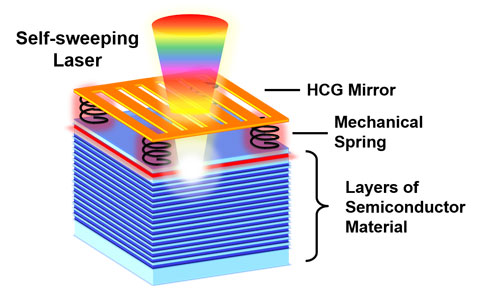New laser design could dramatically shrink autonomous-vehicle 3-D laser-ranging systems
September 4, 2015

This self-sweeping laser couples an optical field with the mechanical motion of a high-contrast grating (HCG) mirror. The HCG mirror is supported by mechanical springs connected to layers of semiconductor material. The red layer represents the laser’s gain (for light amplification), and the blue layers form the system’s second mirror. The force of the light causes the top mirror to vibrate at high speed. The vibration allows the laser to automatically change color as it scans. (credit: Weijian Yang)
UC Berkeley engineers have invented a new laser-ranging system that can reduce the power consumption, size, weight and cost of LIDAR (light detection and ranging, aka “light radar”), which is used in self-driving vehicles* to determine the distance to an object, and in real-time image capture for 3D videos.
“The advance could shrink components that now take up the space of a shoebox down to something compact and lightweight enough for smartphones or small UAVs [unmanned aerial vehicles],” said Connie Chang-Hasnain, a professor of electrical engineering and computer sciences at UC Berkeley.

Google self-driving cars use LIDAR (shown on top) to determine the distance of objects around them (credit: Google)
A system called optical coherence tomography (OCT) used in 3D medical imaging (especially for the retina) would also benefit.
A minaturized 3-D laser-mirror system
A team used a novel concept to automate the way a light source changes its wavelength as it sweeps the surrounding landscape, as reported in an open-access paper in the journal Scientific Reports, published Thursday, Sept. 3.
In both applications, as the laser moves along, it must continuously change its frequency so that it can calculate the difference between the incoming, reflected light and the outgoing light. To change the frequency, at least one of the two mirrors in the laser cavity must move precisely.
“The mechanisms needed to control the mirrors are a part of what makes current LIDAR and OCT systems bulky, power-hungry, slow and complex,” study lead author Weijian Yang explained. “The faster the system must perform — such as in self-driving vehicles that must avoid collisions — the more power it needs.”
The novelty of the new design is that they have integrated the semiconductor laser with the mirror. That means a laser can be as small as a few hundred micrometers square, powered by an AA battery.
The study authors said the next stage of the research will be to incorporate this new laser design in current LIDAR or OCT systems and demonstrate its application in 3-D video imaging.
A U.S. Department of Defense National Security Science and Engineering Faculty Fellowship helped support this work.
* Google’s robotic cars have about $150,000 in equipment including a $70,000 LIDAR system. The range finder mounted on the top is a Velodyne 64-beam laser. This laser allows the vehicle to generate a detailed 3D map of its environment. The car then takes these generated maps and combines them with high-resolution maps of the world, producing different types of data models that allow it to drive itself. — “Google driverless car,” Wikipedia
Abstract of Laser optomechanics
Cavity optomechanics explores the interaction between optical field and mechanical motion. So far, this interaction has relied on the detuning between a passive optical resonator and an external pump laser. Here, we report a new scheme with mutual coupling between a mechanical oscillator supporting the mirror of a laser and the optical field generated by the laser itself. The optically active cavity greatly enhances the light-matter energy transfer. In this work, we use an electrically-pumped vertical-cavity surface-emitting laser (VCSEL) with an ultra-light-weight (130 pg) high-contrast-grating (HCG) mirror, whose reflectivity spectrum is designed to facilitate strong optomechanical coupling, to demonstrate optomechanically-induced regenerative oscillation of the laser optomechanical cavity. We observe >550 nm self-oscillation amplitude of the micromechanical oscillator, two to three orders of magnitude larger than typical, and correspondingly a 23 nm laser wavelength sweep. In addition to its immediate applications as a high-speed wavelength-swept source, this scheme also offers a new approach for integrated on-chip sensors.